 Back to selection
Back to selection
Shutter Angles
Conversations with DPs, directors and below-the-line crew by Matt Mulcahey
“Is That a 58 Degree Dutch Tilt?”: DP Brett Jutkiewicz on Scream
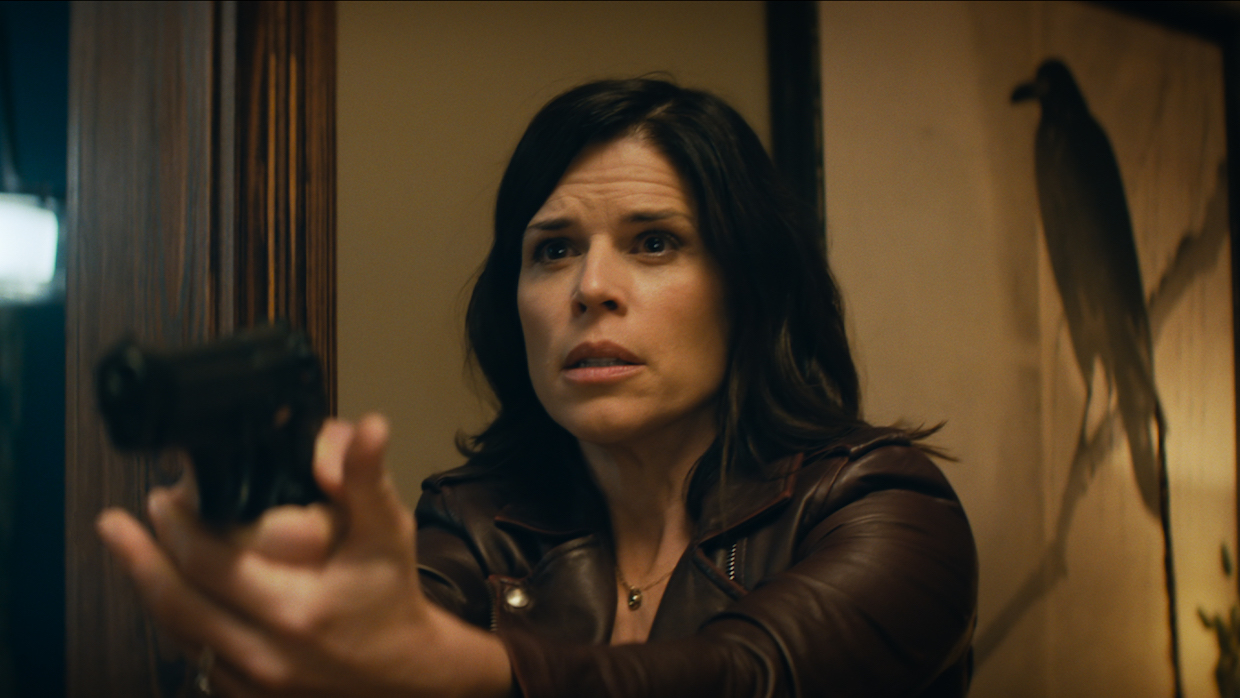 Neve Campbell in Scream
Neve Campbell in Scream In the latest Scream installment, “elevated horror” and “requels” are among the contemporary genre trends affectionately deconstructed. The movie also lobs a little friendly fire toward the 1990s slasher revival that birthed the series—a character quips, “It was really over-lit and everyone had weird hair.”
There’s not much cinematographer Brett Jutkiewicz can do about the latter, but the former served as a gauntlet thrown down. “When you have a line like that in the script, as a DP you think, ‘I guess I better not over-light this thing. I don’t want to end up as the butt of my own joke,’” said Jutkiewicz.
The fifth entry in the Scream series firmly fits into the “requel” category, with a cast of new Woodsboro high schoolers teaming with the surviving legacy characters to battle the surprise killer (or killers, you’re not getting any hints here) hiding under the Ghostface mask this time around.
The film—the first in the series not directed by the late Wes Craven—reteams Jutkiewicz with the Ready or Not triumvirate of directors Matt Bettinelli-Olpin and Tyler Gillett and producer Chad Villella (collectively known as Radio Silence). With Scream now available via streaming and physical media, Jutkiewicz spoke to Filmmaker about the tricks of lighting the Ghostface mask, shooting in Wilmington, North Carolina, and using a detuned set of Panavision G series lenses that offered “all the fun stuff about the C series without the ‘Oh shit!’”
Filmmaker: I was looking back at the interview we did for Ready or Not, and it starts with you talking about how you’re not a huge horror fan. Now, here you are working on one of the most iconic horror franchises ever, and you also shot Scott Derrickson’s The Black Phone, which is coming out this summer.
Jutkiewicz: It was definitely a big deal to be involved in something with such an existing history and fanbase as Scream. It was a little intimidating in that way, but because I had worked with Radio Silence on Ready or Not and really loved their sensibility, I was excited to see what they would do with it and what kind of twist they would put on it.
Filmmaker: The Scream films are so much about commenting on and subverting the expectations of the genre. Did you do a slasher deep dive to feel like you understood what those conventions were?
Jutkiewicz: I wouldn’t say that I necessarily dove into slashers or tried to beef up my knowledge there. I did go back and rewatch all of the Screams. It had been a long time since I had seen any of them and I wanted to get myself more familiar with the storylines and characters. I don’t think I was necessarily looking at them as visual references—although it’s kind of hard to ignore that when I’m watching a film in general—but really I just wanted to re-immerse myself in that world just to have that in the back of my mind.
Once I started talking with Matt, Tyler and Chad and read the script, we didn’t look at a ton of references. The first Scream was really the only one that we talked about as a reference for this one. We liked how they built tension with some of the camera movements and camera angles.
Filmmaker: The Scream films are different than your Friday the 13th or Halloween movies in that the killer isn’t an unstoppable force. The person under the Ghostface mask is eventually revealed to be just a regular person in terms of their physical abilities.
Jutkiewicz: Yeah, definitely. We talked about that a lot. Ghostface has to feel vulnerable in some ways because it’s not some sort of supernatural thing. It’s a real person doing real things, so we are trying to ground ourselves in that. Going back to the original Scream, what was interesting to me was that it’s not a dark movie, lighting wise, but still manages to be scary, creepy and tense. I think that’s really a testament to not only the camerawork but the directing as well. But for this one, I think Radio Silence and I wanted something that felt a little darker and a little moodier.
Filmmaker: Did the legacy of the original films have an effect on the tools you chose? I think all four of the original Scream movies are anamorphic and shot on Panavision lenses. Did you feel tied to either of those things?
Jutkiewicz: One of our early conversations was spherical versus anamorphic, and we all agreed that anamorphic felt right, both because of the feel of the script and also to tie into what had been established as the look of the series. I worked with Panavision to get a set of beautiful G Series anamorphics that they detuned a bit for us so they looked a little less crisp and a little more vintage. We tested the C, G and E Series. We really loved the C Series, which is the older series. We loved the look of them but were a little bit concerned in terms of the focal lengths that were available, and also the surprise factor of how funky they might be in certain situations. Guy McVicker at Panavision did the lens tuning and described the detuned G Series as having “all the fun stuff about the C series without the ‘Oh shit!’” And I was like, “That sounds exactly like what I’m looking for!”
We were fortunate in some ways that we were one of the first bigger productions coming back after the COVID shutdown. We were prepping around August of 2020 and there weren’t a lot of productions going—Panavision was able to accommodate us more easily than they would’ve been otherwise.
Filmmaker: You shot The Black Phone after this?
Jutkiewicz: I did.
Filmmaker: And you shot both in Wilmington? Were you there for like six months?
Jutkiewicz: Basically. I was only back for about a month between those two movies. I came back to New York[(after Scream] right before Thanksgiving and left again right at the beginning of January.
Filmmaker: I grew up on the 1980s movies that Dino De Laurentiis made in Wilmington, things like Silver Bullet and Maximum Overdrive. How was it shooting there?
Jutkiewicz: I’d never been to Wilmington before. I really enjoyed working there. The local crew was fantastic. There’s a great little film community in Wilmington. The stage that [De Laurentiis] built is still there and that’s the only big stage in town, so that’s where everybody shoots for stage work. Another advantage of being one of the first productions back was most of the crew was available. We were able to get some really great crew together. It’s a laid back place to make a movie, which was nice. It’s on the coast and you could actually go the beach on the weekends, which was amazing.
Filmmaker: The opening kill scenes are one of the staples of the Scream films. As the series went on, they kept piling on the layers of metatextuality for those openers. The first scene here is more of a throwback to the simplicity of the initial Scream.
Jutkiewicz: For that scene, we knew we wanted to play with the interaction between [Jenna Ortega’s character] and her phone. So, we knew we would get some color contrast between the cooler glow from the phone on her face and the warmer ambient environment of the house, which was nice because that phone light gave her a great motivated eye light. We were on the Steadicam for most of that sequence and it was just about creating this space that Jenna could move through with very limited adjustments lighting-wise. I really liked the floatiness of the Steadicam. It added a bit to the tension of the scene, being able to make these small moves and slight wraps and feel like there’s another sort of presence in the room.
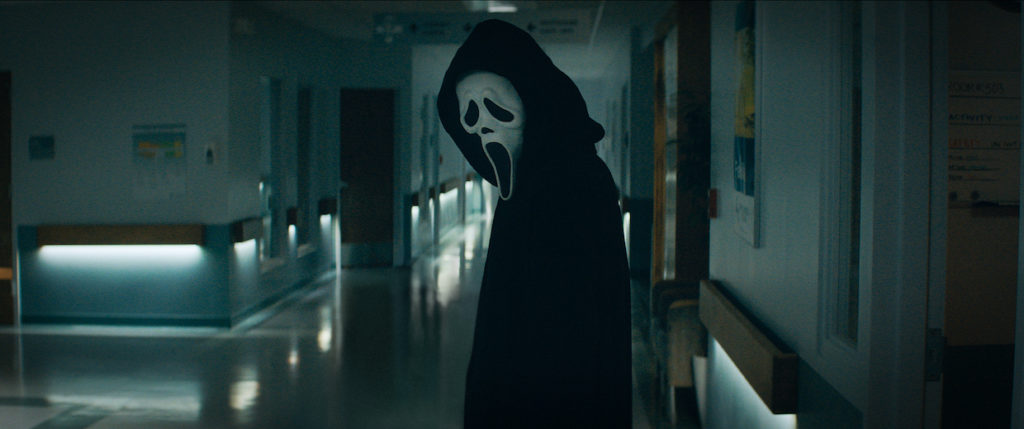
Filmmaker: I enjoyed what you did with the color of your hospital scenes, where we get this blue/green look with hallway lights underneath the railings.
Jutkiewicz: That was a build we did on stage. We did some scouting for hospitals but because of the amount of time we spend in there and how big the sequences were, fortunately, they allowed us to make that a build. The underlighting of the handrails came from some hospital references that our production designer, Chad Keith, showed me. I’d never seen that before, but it looked really interesting. When Ghostface comes in the hospital I had the idea of doing a lighting shift where the main lights are cut and you have these emergency lights that come on and illuminate the pathway. Those lights are RGBA LED ribbon that our electric department rigged under the handrails so we could have full control over the color and dimming.
Filmmaker: Was the Ghostface mask difficult to light? It’s white against an otherwise black costume. Were there certain types of light the mask looked best in?
Jutkiewicz: In some ways, what’s nice about the mask is that it’s white—if Ghostface is in a dark environment, you’re not struggling to get detail out of the mask. There’s also no eyes, so you’re not dealing with trying to get an eye light in there. We did have an LED tube that we would bring in for certain situations to create a little bit of shine on the mask if we needed it, but for the most part we were letting him just exist in the environments. If Ghostface was moving through space we might have a little handheld unit that one of the electrics would walk with to give the mask a little pop, but usually just the mask being white made it tend to stand out in most of the situations that we needed it to.
Filmmaker: In the movie we see a few shots from the fictitious Stab series, including a funny bit with Ghostface in cut-off-sleeves and a flamethrower.
Jutkiewicz: When we shot that [flamethrower] image, I think we did a little bit more [than what ended up in the movie]. I don’t remember what exactly made it into the final cut. There was a scene of him chasing somebody with a pitchfork. We also shot [laughs] a daytime scene of him running after a group of kids that didn’t make it into the movie. Those were fun. I told my gaffer, Steve Thompson, “Let’s find the most garish, overly saturated blue-green gels we can and put them on a big, hard light up in a Condor.” So, it was fun to have a little license to do something that felt more over-the-top, where the more ridiculous it was, the better. The time that we had to do those was so limited. We ran out of the stage at the end of a day; the team had been working on prelighting and we just threw the camera up and started trying to get that stuff done. I wish we’d had time to shoot more of it, because I really enjoyed it.
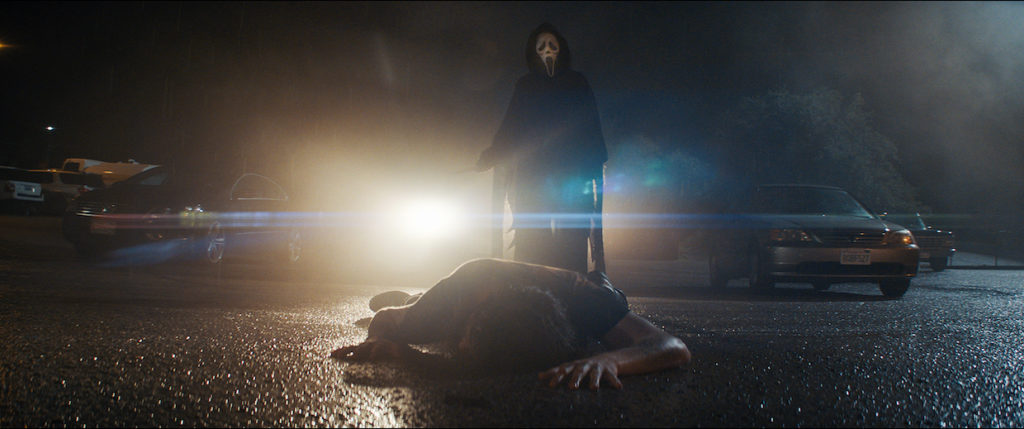
Filmmaker: One of my favorite scenes, particularly in terms of lighting, is the kill scene in the alleyway behind the bar where the action is motivated by car headlights.
Jutkiewicz: That’s one of my favorite sequences as well. We struggled to find that location. We couldn’t find an interior and exterior that worked together for the bar. For the exterior, we ended up using the back of some sort of union hall. That is an example of why I really like collaborating with the Radio Silence guys, because that headlight gag was never scripted. That was something that came out in our conversations together, and we were able to reblock and rethink the scene a little bit to make it work. They’re really receptive to that sort of thing. Their philosophy is, “The best idea wins,” and I think that’s how they function as a collective.
That was another scene we were shooting towards the end of our day and running out of time. I remember one of the headlight bulbs died. We rigged our own headlights into the car to make them super bright and controllable, and one of them was petering out. We were rushing to get it back working so we could finish.
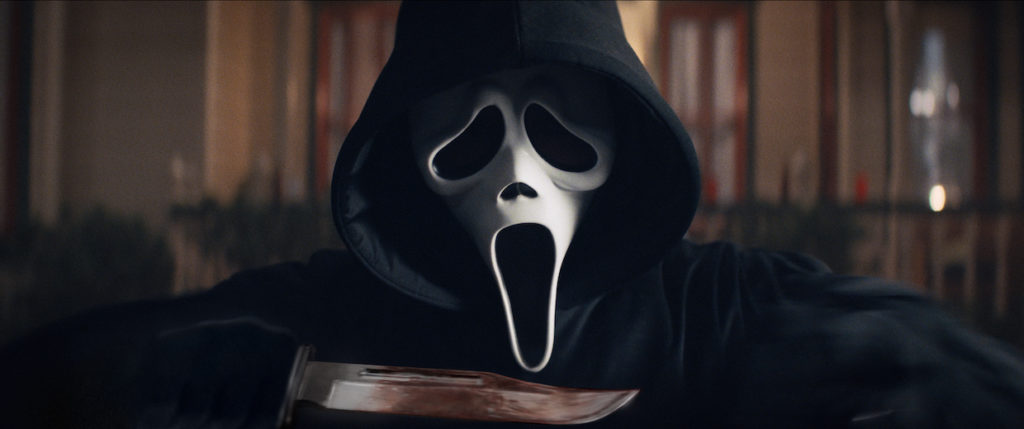
Filmmaker: I like the shot where the headlights cast Ghostface’s gigantic shadow on the wall.
Jutkiewicz: I don’t think that shadow shot actually ended up in the movie. I think it’s just in the trailer. That was another thing that we hadn’t necessarily planned on doing. On the day we noticed it as we were getting set up.
That reminds me of another thing that’s in the trailer but not in the movie. Ghostface is walking into focus and wipes the knife off outside of the house. It was our last shoot day and we were about to wrap the movie on an insert. I said to Tyler, Matt and Chad, “We just can’t end this shoot on an insert! We have a little bit of time. Let’s just grab something cool.” So, we walked around the [house used for the finale] and went out front and I was like, “What if Ghostface just comes sprinting out of the house into focus and stops in front of camera?” So, that’s the shot we ended the shoot on and now it’s in all the marketing materials. (laughs)
Filmmaker: For Ready or Not, you were shooting in a practical location that had all these restrictions, because it was a historic building. For the final act of Scream, was it nice to have the control of a soundstage?
Jutkiewicz: Yeah, it was nice. Being able to put lights wherever I wanted to was certainly a big advantage of shooting on the stage. There’s also advantages to being on location. On Ready or Not, we found interesting ideas for shots based on the layout of the practical location that we might not have thought of otherwise. With a build, the surprise of finding things is a little bit less, but there are certainly a lot of advantages to a build, like being able to put holes in walls or drop things from the ceiling. It was a challenge because we were doing both the interiors and exteriors of that house inside on stage. So, there was a little bit of VFX extension on the house itself, but I think only for when we see it really wide at the very end of the movie. For most of the exteriors we had painted backdrops and did it all in-camera.
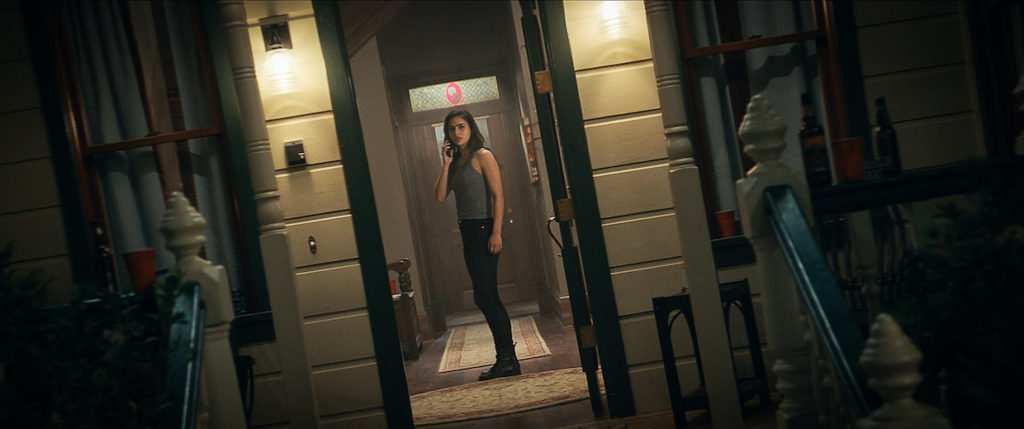
Filmmaker: The identity of that particular house isn’t revealed until later in the film. For the early scenes there, how did you plan the coverage so that people who are fanatics about the series didn’t notice before you wanted them to?
Jutkiewicz: Trying to hide the reveal of the house until the right place in the story was definitely something we talked about a lot. Part of how we did that was just not shooting wide shots. The other thing was, during the party scene there we used colorful moving party lights so that we could keep it pretty dark inside to help hide the house. For the most part, we just tried to keep things tighter before we pull out the front door and really reveal the house for the first time.
Filmmaker: The most self-reflexive bit in the movie comes when you recreate the moment in the first Scream where Randy is on the couch watching Halloween on TV warning Jamie Lee Curtis’s character to look behind her….while Ghostface creeps up behind him. Here, you have a character on the couch watching the Stab version of that Randy scene on the TV while Ghostface creeps up behind her. It’s pretty much meta to the infinite power.
Jutkiewicz: I know. That was a lot of fun to play around with. We’d examine the original and be like, “Is that a 58 degree Dutch tilt? Maybe it’s 64 degrees?” We tried to match it pretty closely. That was a fun homage. It really reminded me just how much of a legacy our film was going to be a part of.
